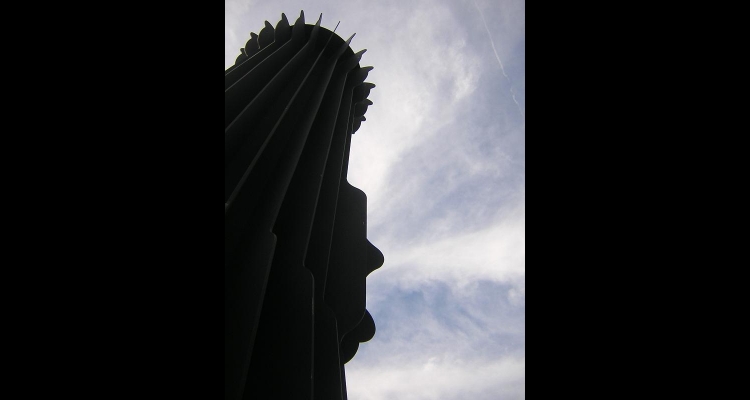Claes Oldenburg and Coosje van Bruggen
Visitors to the campus of the University of Nevada, Las Vegas (UNLV) are sometimes puzzled by the black column on the plaza between Judy Bayley Theatre and Artemus W. Ham Concert Hall. Closer inspection reveals an almost four-story-high variation on the classic mid-twentieth century ribbed, rubberized Rayovac flashlight. Indeed, it is Flashlight by Claes Oldenburg (b. Sweden, 1929) and Coosje van Bruggen (b. Netherlands, 1942), commissioned in 1978 and installed in 1981.
UNLV had approved the original design with the light of Flashlight (painted steel, height 38.5 feet, diameter 10.5 feet) pointed skywards. In his Art in America review of Oldenburg's 1995 Guggenheim exhibit, Robert Haywood indicates that van Bruggen apparently had last-minute doubts regarding the sculpture's relationship to the casinos' neon designs as well as its sexual connotations. She articulated the sides with vertical ridges (which Haywood oddly likens to a cactus), exaggerating a classic flashlight design, and turned the sculpture upside down, its light buried in the pavement. If anything, the gesture made Flashlight even more amusing—a hidden light in a city defined by its excess of light; a secret light in a city whose entertainment industry is dedicated to erasing social taboos; a hard-to-find light on the campus of a university, a place dedicated to illuminating ideas and culture.
Flashlight was well within the style defined by the artist's earlier works. Oldenburg matured artistically in New York City in the late 1950s when artists were beginning to explore the legacy of Abstract Expressionism. Influenced also by Marcel Duchamp, Edward and Nancy Kienholz, and others, Oldenburg experimented with theatrical installation work. In the components of these early environments, Oldenburg found his ideas for soft sculpture, like Floor Burger (1962), Ghost Toilet (1966), and the highly political Lipstick (1969–1974).
Oldenburg's collaborator on the soft sculpture was his then-wife, Patty Mucha, who engineered and sewed the large unwieldy forms stuffed with kapok. Since 1976 he has collaborated with van Bruggen.
In 1962, Oldenburg exhibited Floor Burger. In that year, Andy Warhol first exhibited his famous Campbell Soup Cans, which used the graphic design of mass media and consumer objects to invade the world of fine art, and met with gasps of delight and derision—as did Oldenburg's work. Both raised questions about the place and weight of the tradition of high art in western civilization and culture. As much as the work of Oldenburg, Warhol, and other Pop artists was a serious challenge to the usual definition of art (the individual's unique hand versus mass production, appropriate subject matter, and materials) in the United States, it was also meant to amuse and to make art widely accessible.
With Lipstick, and then Clothes Pin (Philadelphia, 1976) Oldenburg and van Bruggen introduced scale as an important component in their designs. The small and ordinary consumer product was made monumental, which suggested a significance the object would not otherwise have. Humor naturally follows from the patent absurdity that a clothes pin, lipstick, flashlight, hamburger, safety pin, or baseball bat would have profound meaning meriting such scale.
Oldenburg revisited Flashlight in a lithograph in 1982, Colossal Flashlight in Place of the Hoover Dam (Jordan Schnitzer Collection, Oregon). His humor again layered, the folly of a gargantuan flashlight-as-dam provided diversion from the seemingly illogical notion of battery power replacing hydroelectric power on such a grand scale.
Article Locations
Related Articles
None at this time.
Further Reading
None at this time.
